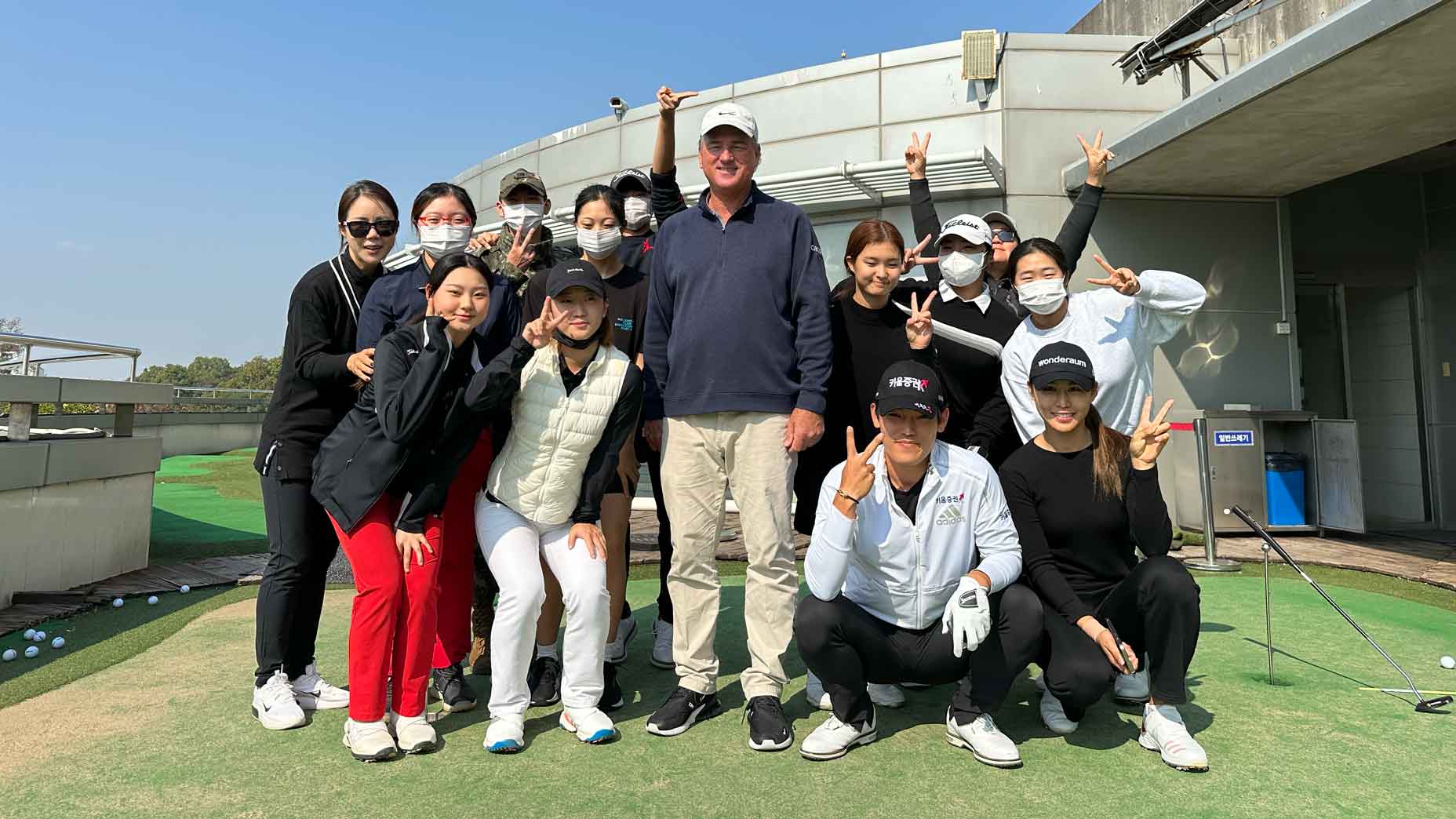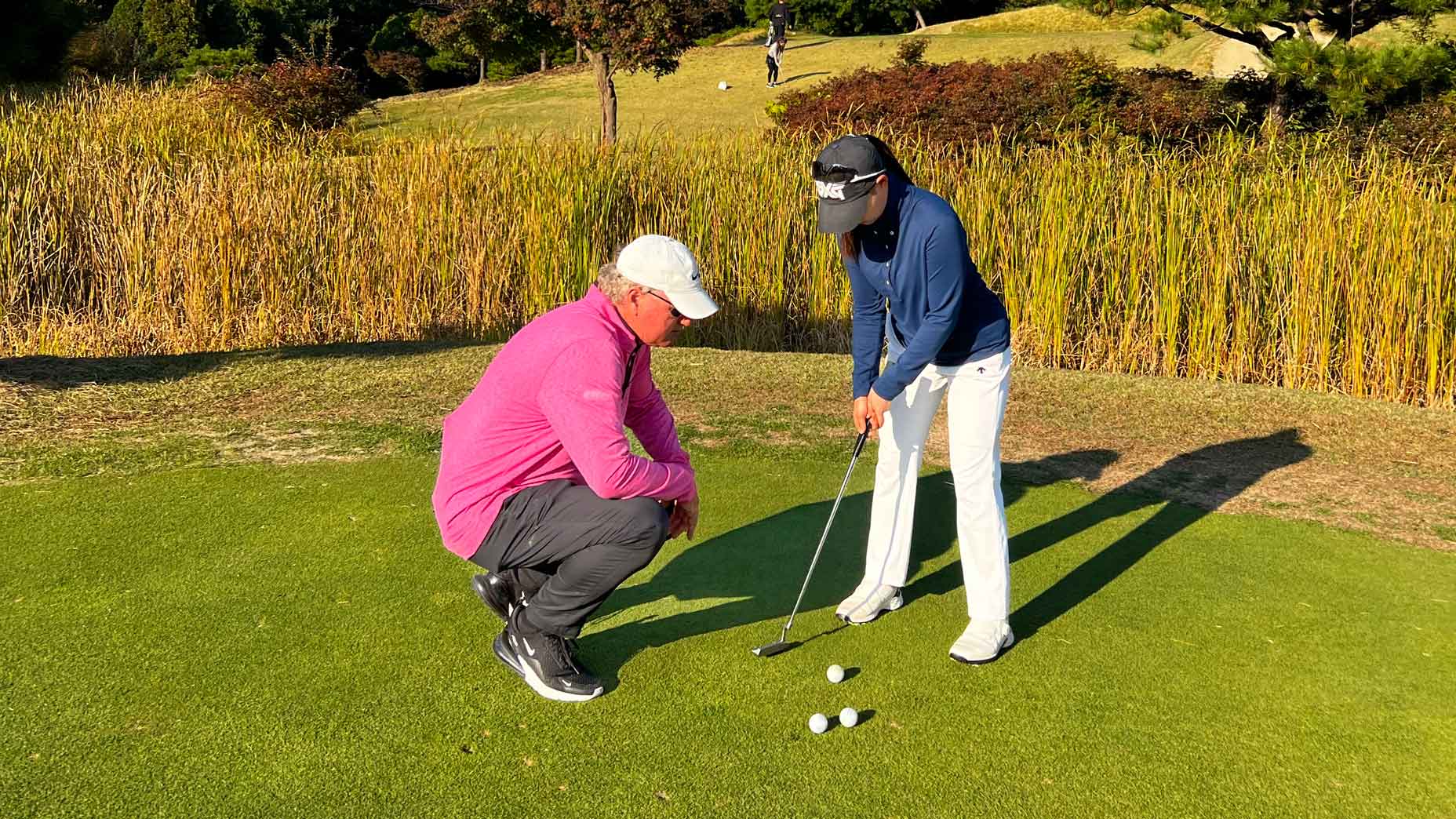
Top 100 GOLF teacher Brian Mogg and some of his South Korean instructors.
Courtesy of Brian Mogg
Each of us knows the moment when we fell in love with the sport. Many of us around my age (40) call the picture of a 21-year-old Tiger Woods from No. 18 at Augusta National after his victory at the 1997 Masters. It wasn’t just the flaming frenzy after the tear, it was Woods’ embrace of his father, Earl, that forever cemented the emotion, joy and inspirational power of the game.
What was that united moment – or who was that mighty hero – for the people of South Korea?
“Simple answer: Se-Ri Pak,” said GOLF Top 100 Teacher, Brian Mogg, who has run the academy in this country since 2009. “Some 20 or 22 year olds, we ask them if they have arrived how here, their reason for playing is. They all say the same thing: ‘When I was three years old, I saw Se-Ri on TV holding a trophy and I wanted to be like him.’ ”
To understand exactly why Pak – a 25-time winner on the LPGA Tour and a 2007 World Golf Hall of Fame inductee – remains a cult icon in South Korea, you must first get used to a culture that puts a strong emphasis on pride. discipline, competition and respect. Ask any professional golfer what it takes to excel and those words are likely to come up.
It is that attention to detail that has made South Korea a golf education center. But unlike in the States, the experience is more than just a few hours a week between the student and the teacher. It’s a lifestyle commitment that often affects the player’s entire family. Mogg understood this early and hired former LPGA players to serve as coaches at his school in Seoul. These are not just teachers; they deliberately play the role of parental figures for many of the students.
“It’s a big part of my success,” says Mogg.

Courtesy of Brian Mogg
Despite the general support provided by the Mogg team, parents are still heavily involved in every aspect of the player’s development. Mogg remembers the whole experience of one of his first students who eventually became a professional, and as is common in Korea, was read to increase the family’s wealth.
He says: “Often when the student comes to his studies, the family also comes. “The family is buying a dream, and it is the family’s dream that this child will raise them to the highest level. It’s bigger than going pro. It is expected that these children will be the next stars. ”
Probably for good reason. Kids don’t play regular golf in Korea. They are not even allowed in many courses. They may or may not be on a competitive path, in part because in-state tuition is expensive – about ten grand a month at a regular school. That pressure goes back to the player if they are lucky enough to make it to the pro circuit. And, remarkably, many do. In the current Rolex rankings, 30 of the top 100 women golfers in the world are from Korea.
Brian Mogg is not the only educator affected by the strong commitment of young Koreans. Kenny Kim, a former UC Irvine student and pro who is one of two Korean instructors at GOLF Top 100 Teacher Chris Mayson’s school, grew up in Korea before moving to the United States at age 11 to pursue the game. which under the influence of. his parents, who thought that the States would prepare him better for a career in the game.
After his playing days ended at the age of 29, Kim returned to Korea to focus on helping young golfers learn the game, using his upbringing as a framework to connect with values. theirs and hard work. His students work non-stop.
He says: “It’s Monday to Friday or Saturday.” “These kids are here all day, every day. I know they are determined.”
Everything, Kim says, is about competition. “[In Korea]kids will tell me how they need to shoot 80 to beat another kid. I’m like, ‘No, you just need to find out better.‘”
Another big difference between education in Korea and abroad? Kim says: “We work in the gym, but we don’t really have the opportunity to go to the golf courses. Mogg agrees, describing small isolated rooms where students, with mats and eye glasses, will spend hours practicing.
He says: “An American player spends 90 seconds there every day, but these kids spend an hour there with two or three feet, trying to see if they can start the ball straight. ”
There is a widespread perception that Korean golfers come from a rigid, robotic system. In fact, the system not only allows individual choice, but encourages it. It’s another unique change that Mogg has to make. The teaching style – where you commit to only one teaching method – is not considered acceptable in Korea. The most successful educators take an individualized approach.
“Even though the Korean learning style is more leftist and technical, you still have to work with the individual, treat them as individuals and make sure your lessons are taught,” says Mogg. in that way. I have to fight my instincts and [adapt] about how they naturally learn best.”
However, Mogg finds teaching in this country very rewarding. He had the honor of coaching the first Asian-born major champion, YE Yang, who came from behind to defeat Tiger Woods in the 2009 PGA Championship.
The memories are still fresh. Mogg says: “After YE KE won the PGA, we arrived in Seoul at 4:30 in the morning. “YE’s holding the Wanamaker Trophy and we’re coming out of this little baghouse, turning the corner, and it had to be like The Beatles coming to America – the hero went home and all of Seoul was in the room of waiting. say hello and celebrate him.
There is no doubt that somewhere in Seoul, a young Korean was watching Yang and his big trophy, probably seeing himself in him and loving the sport.
We all have that one moment.
#South #Korea #improving #game #golf #lifelong #commitment #family


